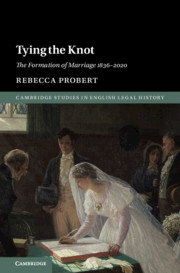Book contents
- Tying the Knot
- Cambridge Studies in English Legal History
- Tying the Knot
- Copyright page
- Dedication
- Contents
- Preface and Acknowledgements
- Abbreviations
- 1 Introduction
- 2 Conception, Design, and Implementation, 1819–1837
- 3 Reactions to the Act, 1837–1854
- 4 Amendments Enacted and Reform Deferred, 1855–1872
- 5 Differences, Divisions, and Dispensing with the Registrar, 1873–1899
- 6 Competing Conceptions of Marriage, 1900–1919
- 7 Consolidating Complexity, 1920–1949
- 8 Convergence? 1950–1993
- 9 The Rise of the Wedding, 1994–2020
- 10 The Legacy of the Past and Lessons for the Future
- Index
2 - Conception, Design, and Implementation, 1819–1837
Published online by Cambridge University Press: 10 September 2021
- Tying the Knot
- Cambridge Studies in English Legal History
- Tying the Knot
- Copyright page
- Dedication
- Contents
- Preface and Acknowledgements
- Abbreviations
- 1 Introduction
- 2 Conception, Design, and Implementation, 1819–1837
- 3 Reactions to the Act, 1837–1854
- 4 Amendments Enacted and Reform Deferred, 1855–1872
- 5 Differences, Divisions, and Dispensing with the Registrar, 1873–1899
- 6 Competing Conceptions of Marriage, 1900–1919
- 7 Consolidating Complexity, 1920–1949
- 8 Convergence? 1950–1993
- 9 The Rise of the Wedding, 1994–2020
- 10 The Legacy of the Past and Lessons for the Future
- Index
Summary
The conception and design of the Marriage Act 1836 was shaped by the various unsuccessful proposals for reform that were advanced between 1819 and 1835. Protestant Dissenters were deeply divided on the question of what shape reforms should take. Some proposals for reform applied only to specific religious groups, while others were general in scope. Some focused on regulating marriages in places of worship, while others proposed a new secular alternative. The challenge for lawmakers was to establish a process that was sufficiently rigorous to assuage any concerns about a new law being used as a cloak for clandestinity and sufficiently independent of the existing Anglican structures to satisfy Dissenters. The solution was found in the machinery of the New Poor Law, which provided the basis for a new system of civil registration. Yet the 1836 Act’s reliance on this machinery was to pose problems, the most pressing being that it was not yet in place in most parts of the country. The implementation of the New Poor Law had to be speeded up, generating considerable opposition, and various makeshift provisions had to be put in place for the parishes that remained outside its ambit.
- Type
- Chapter
- Information
- Tying the KnotThe Formation of Marriage 1836–2020, pp. 21 - 53Publisher: Cambridge University PressPrint publication year: 2021

